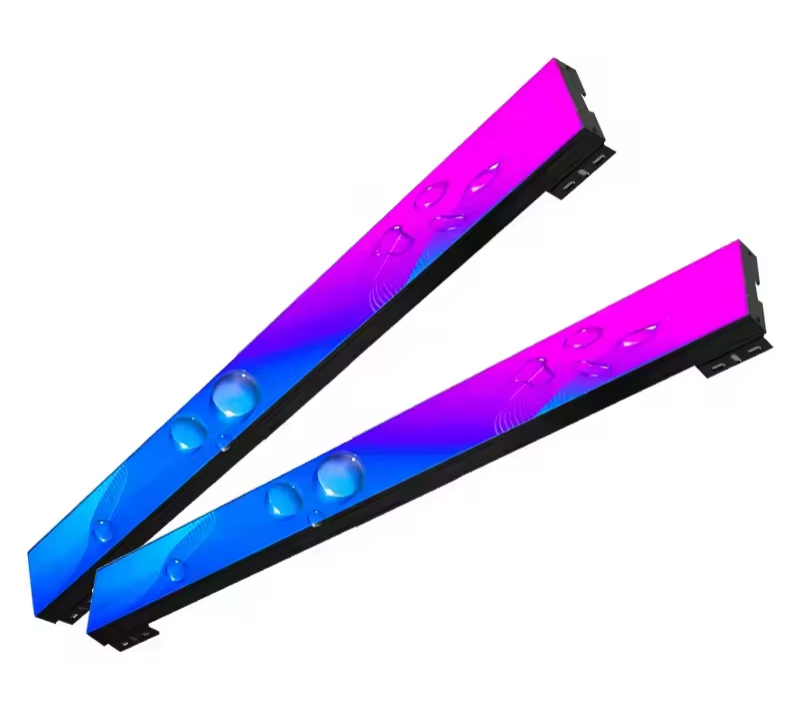
High-definition shelf strip screens are growing rapidly in various fields. As a smart display solution, it combines pictures, videos, text, sound, high definition, bright colors and other characteristics. Choosing the right high-definition shelf strip screen and placing it reasonably is crucial to the beauty of the supermarket, shopping efficiency, and information display.
So what is an LED shelf screen/strip screen?
An LED shelf screen is a long strip of LED display screen installed in various application scenarios, usually connected to a controller, receiving card, and power supply.
The box is made of aluminum profiles, the product is light and thin, fashionable and beautiful, and durable and not easy to deform.
It can display product information, promotional activities, brand promotion and various notification information with high resolution. It can not only replace traditional product labels, but also promote products through dynamic and static video content, which improves the customer’s shopping experience. Other application scenarios can better play the role of information notification.

LED shelf screen/strip screen size
All sizes are produced according to the length and height provided by the customer. From this aspect, we can see that the product is flexible and has no limitations.
The module size of Shenzhen Chinastar LED shelf screen/strip screen new products is: 300X60mm\200X50mm
The conventional box sizes of LED shelf screen/strip screen products in actual applications are: 300\600\900\1200x60mm; 400\600\800\1000\1200x50mm.
LED shelf screen / strip screen role
Promotion and advertising: supermarket shelf screens can be used to display promotional information, specials and advertising campaigns. By attracting customers’ attention, these screens can increase the popularity of specific products or services and promote sales.
Shopping guides and instructions: supermarket shelf screens can be used to provide guidance and navigation information to help customers better find the location of the desired goods. They can display product categories, shelf numbers and product details to make the shopping experience more convenient and efficient.
News and entertainment: supermarket shelf screens can play news, weather forecasts, entertainment programs and other related content to provide customers with information and entertainment, and increase the vitality and attractiveness of the shopping environment.
Digital display: supermarket shelf screens can be used to display pictures, videos and features of products to help customers better understand and compare different products. This digital display can enhance the attractiveness and competitiveness of products.
Data statistics and analysis: supermarket shelf screens can collect data on customer interaction with the screen, such as clicks and dwell time, as well as purchasing behavior, which can be used for statistical analysis and market research to provide decision support for supermarket managers.
Display and reminder of information: Display conference content, exhibit information, instruction information, etc. to help participants and audiences better understand and participate; display traffic instructions, road conditions, schedule information, etc. to help people travel better; display game scores, timings, replays and other game information to enhance the audience’s viewing experience.
Application scenarios of LED shelf screens/strip screens、
1. Application scenarios in the retail field
Brand chain: mainly for luxury goods, fashion shoes and clothing stores, sports brands, technology companies, light luxury goods;
Retail chain: mainly for pharmacies, gas stations, 4S stores, etc.;
Shopping Mall: mainly for large leisure shopping centers;
Department stores: mainly for comprehensive supermarkets and professional supermarkets;
Warehouse-style supermarkets: mainly for wholesale and retail warehouse-style supermarkets;
Catering chains: mainly for tea shops, coffee shops, bakeries, bars, branded fast food, etc.
2. Application scenarios in the public field
Transportation hubs (subway stations, high-speed rail stations, railway stations, airports), hospitals, libraries, vehicle information notices (buses, taxi roofs, subway cars, trains, trains), store fronts, elevator entrances, sports events, gyms, billiard rooms, conference centers, exhibition halls, cinemas and other scenarios.

